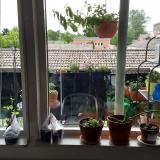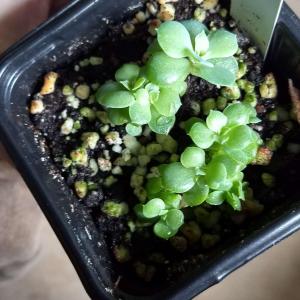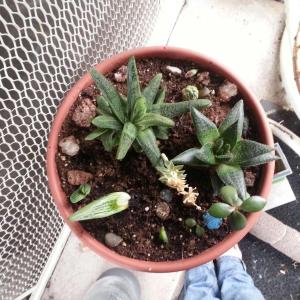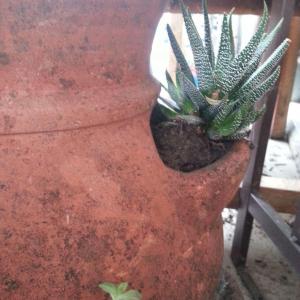文章
Dummer. ゛☀
2017年09月13日

They may look like little fluffy cotton balls with legs, but the damage mealybugs can do in the flower garden is serious. Mealybugs, a cousin to other garden pests like scale and whiteflies, can damage many flowering and ornamental plants by direct feeding and by introducing diseases into the garden. Organic flower gardeners can control this pest in several ways without resorting to toxic pesticides.
Identify Mealybugs and Mealybug Damage
Mealybugs are tiny insects, about 1/8 inch in length, but their color and clustering habit make mealybugs easy to find on garden plants. Most common mealybug species are white, and have waxy looking filaments covering their bodies, giving them a fuzzy or hairy appearance. An exception is the hibiscus mealybug, which is pinkish-brown and lacks the fringe.
Mealybugs feed on garden plants by inserting their sharp mouthparts into the leaves and stems to suck sap. Damaged leaves look wrinkled or puckered, and the insects can contaminate cut flowers with webby egg sacs and clusters of larvae. The honeydew mealybugs excrete compounds the damage, as it harbors black sooty mold and encourages the growth of plant viruses.
Integrated Pest Management for Mealybugs
Several species of parasitic wasps prey on mealybugs, so flower gardeners should attract these predators with nectar rich plantings of yarrow, sweet alyssum, and bee balm.
Lacewings and pirate bugs also feed on mealybugs, so gardeners should be aware of the possibility of damaging these pests with insect spray, even if the spray is organic.
The honeydew mealybugs exude attracts ants, which aren’t pests themselves, but protect mealybugs from natural predators. Planting common vetch as a cover crop can draw ants away from mealybugs by providing a supplemental nectar source.
Gardeners can also discourage ant colonies by tilling the surface of the soil to disrupt nests.
Biological Pest Control for Mealybugs
Organic gardeners have at least two commercial options for biological mealybug control. The ladybug species Cryptolaemus montrouzieri, commonly called the mealybug destroyer, feeds voraciously on mealybugs at all stages of development. In fact, gardeners must take care not to mistake this beneficial insect for a pest, as the larvae of this ladybug resemble mealybugs. Gardeners can order adult mealybug destroyers to release during periods of high infestation, and this ladybug will feed on other garden pests like aphids or thrips when the mealybugs are gone.
Gardeners can use the OMRI (Organic Materials Review Institute) approved insect-killing fungus marketed under the trade name Mycotrol, which contains spores of Beauveria bassiana. Gardeners can use this product until the day of harvest for cut flowers, as it’s safe for people, animals, and the environment.
Organic Sprays for Mealybugs
As soft bodied insect pests, mealybugs are susceptible to insect soap sprays. Gardeners must spray mealybugs directly with the insect soap to disrupt the cell membrane and kill the insects, so this spray doesn’t work as a preventative agent.
The biggest drawback of insect soaps is their potential to damage or burn plants. To reduce plant toxicity, spray plants in the evening and spray them with water in the morning, as high temperatures and sunlight increase plant damage from insect soap.
Mealybugs on Houseplants
Mealybugs and their nymphs thrive in greenhouses, making this insect pest common on houseplants. Orchids are particularly susceptible to damage and death from mealybug infestations. Isolate new houseplants for one week before placing them around other houseplants. Inspect the plants each day for signs of white mealybugs or their webbing, and kill any insects with a cotton swab dipped in rubbing alcohol.

Identify Mealybugs and Mealybug Damage
Mealybugs are tiny insects, about 1/8 inch in length, but their color and clustering habit make mealybugs easy to find on garden plants. Most common mealybug species are white, and have waxy looking filaments covering their bodies, giving them a fuzzy or hairy appearance. An exception is the hibiscus mealybug, which is pinkish-brown and lacks the fringe.
Mealybugs feed on garden plants by inserting their sharp mouthparts into the leaves and stems to suck sap. Damaged leaves look wrinkled or puckered, and the insects can contaminate cut flowers with webby egg sacs and clusters of larvae. The honeydew mealybugs excrete compounds the damage, as it harbors black sooty mold and encourages the growth of plant viruses.

Integrated Pest Management for Mealybugs
Several species of parasitic wasps prey on mealybugs, so flower gardeners should attract these predators with nectar rich plantings of yarrow, sweet alyssum, and bee balm.
Lacewings and pirate bugs also feed on mealybugs, so gardeners should be aware of the possibility of damaging these pests with insect spray, even if the spray is organic.
The honeydew mealybugs exude attracts ants, which aren’t pests themselves, but protect mealybugs from natural predators. Planting common vetch as a cover crop can draw ants away from mealybugs by providing a supplemental nectar source.
Gardeners can also discourage ant colonies by tilling the surface of the soil to disrupt nests.

Biological Pest Control for Mealybugs
Organic gardeners have at least two commercial options for biological mealybug control. The ladybug species Cryptolaemus montrouzieri, commonly called the mealybug destroyer, feeds voraciously on mealybugs at all stages of development. In fact, gardeners must take care not to mistake this beneficial insect for a pest, as the larvae of this ladybug resemble mealybugs. Gardeners can order adult mealybug destroyers to release during periods of high infestation, and this ladybug will feed on other garden pests like aphids or thrips when the mealybugs are gone.
Gardeners can use the OMRI (Organic Materials Review Institute) approved insect-killing fungus marketed under the trade name Mycotrol, which contains spores of Beauveria bassiana. Gardeners can use this product until the day of harvest for cut flowers, as it’s safe for people, animals, and the environment.

Organic Sprays for Mealybugs
As soft bodied insect pests, mealybugs are susceptible to insect soap sprays. Gardeners must spray mealybugs directly with the insect soap to disrupt the cell membrane and kill the insects, so this spray doesn’t work as a preventative agent.
The biggest drawback of insect soaps is their potential to damage or burn plants. To reduce plant toxicity, spray plants in the evening and spray them with water in the morning, as high temperatures and sunlight increase plant damage from insect soap.

Mealybugs on Houseplants
Mealybugs and their nymphs thrive in greenhouses, making this insect pest common on houseplants. Orchids are particularly susceptible to damage and death from mealybug infestations. Isolate new houseplants for one week before placing them around other houseplants. Inspect the plants each day for signs of white mealybugs or their webbing, and kill any insects with a cotton swab dipped in rubbing alcohol.
0
0
文章
Dummer. ゛☀
2017年09月13日

HESE small, soft-bodied, pear-shaped insects cluster densely on tender new growth and the undersides of leaves to suck plant juices. Plants often can withstand some aphid feeding with no adverse effect, but badly infested plants develop distorted growth and leaves may turn yellow or drop off.

Sometimes it takes close inspection to discover an aphid infestation. They blend in so well with foliage that you may not spot them at first glance, even though hundreds are present. Many species of aphids feed on home garden plants; these insects range in color from pale green, pink, or black to red or yellow. Size is typically 1/16″–1/4″. Adult aphids are generally wingless, but winged adults will appear when overcrowded. Immature aphids (nymphs) closely resemble adults.

Both adults and nymphs feed on a wide variety of plants, including most edibles and ornamentals. In small numbers aphids do little damage, but they are able to reproduce rapidly and can quickly become a more serious problem. Also, as they feed, aphids secrete a sweet fluid called honeydew that can attract ants; sooty black fungus may grow on coated leaves. Aphids are common throughout the U.S.

Prevention and control
When fertilizing your garden, avoid applying too much nitrogen, which can stimulate plants to grow too rapidly and produce a flush of exactly the kind of tender new growth that aphids love.
Attract and release beneficial insects, such as ladybugs and lacewings, which will be happy to devour a bountiful supply of aphids.
Use a spray with neem oil, which is derived from the seed of the neem tree. It controls a wide variety of common garden insect pests such as aphids as well as fungal diseases.
Use a strong spray of water from your hose to dislodge aphids from affected plants. This will reduce their numbers dramatically. Recheck the plants a few days later and repeat the treatment if needed. (Keep in mind that water sprays will also kill beneficial insects.)

Sometimes it takes close inspection to discover an aphid infestation. They blend in so well with foliage that you may not spot them at first glance, even though hundreds are present. Many species of aphids feed on home garden plants; these insects range in color from pale green, pink, or black to red or yellow. Size is typically 1/16″–1/4″. Adult aphids are generally wingless, but winged adults will appear when overcrowded. Immature aphids (nymphs) closely resemble adults.

Both adults and nymphs feed on a wide variety of plants, including most edibles and ornamentals. In small numbers aphids do little damage, but they are able to reproduce rapidly and can quickly become a more serious problem. Also, as they feed, aphids secrete a sweet fluid called honeydew that can attract ants; sooty black fungus may grow on coated leaves. Aphids are common throughout the U.S.

Prevention and control
When fertilizing your garden, avoid applying too much nitrogen, which can stimulate plants to grow too rapidly and produce a flush of exactly the kind of tender new growth that aphids love.
Attract and release beneficial insects, such as ladybugs and lacewings, which will be happy to devour a bountiful supply of aphids.
Use a spray with neem oil, which is derived from the seed of the neem tree. It controls a wide variety of common garden insect pests such as aphids as well as fungal diseases.
Use a strong spray of water from your hose to dislodge aphids from affected plants. This will reduce their numbers dramatically. Recheck the plants a few days later and repeat the treatment if needed. (Keep in mind that water sprays will also kill beneficial insects.)
0
0
文章
Dummer. ゛☀
2017年09月13日

When this bacterial disease infects young cabbage-family plants, the leaves turn yellow and plants become stunted and die. In older plants, first signs of infection are usually on the lower leaves, which develop yellow, V-shaped lesions at their edges. The infection gradually spreads toward the center of the leaf, and the veins within this dead tissue turn black. As the disease progresses, the heads of cabbage and cauliflower may rot.

The bacterium is spread by insects and splashing water and on contaminated tools. Warm, humid weather encourages the disease, which occurs in most of North America, but is most common in the East.

Prevention and Control
Plant certified disease-free seed and transplants.
When possible, choose varieties that are resistant to black rot.
If space in your garden allows, follow a three- to four-year crop rotation to avoid planting susceptible crops in the same area.
Use drip irrigation or soaker hoses rather than overhead watering to keep foliage dry.
Destroy or deeply bury infected plants.

The bacterium is spread by insects and splashing water and on contaminated tools. Warm, humid weather encourages the disease, which occurs in most of North America, but is most common in the East.

Prevention and Control
Plant certified disease-free seed and transplants.
When possible, choose varieties that are resistant to black rot.
If space in your garden allows, follow a three- to four-year crop rotation to avoid planting susceptible crops in the same area.
Use drip irrigation or soaker hoses rather than overhead watering to keep foliage dry.
Destroy or deeply bury infected plants.
0
0
文章
Dummer. ゛☀
2017年09月13日

Water-soaked spots on blossoms or leaves are an early symptom of this fungal disease. A cottony white growth may develop on the spots. White mold attacks many types of edible plants, including beans, peas, potatoes, soybeans, carrots and cabbage. White mold gradually spreads to all above-ground plant parts. Infected tissues wilt, yellow and die. Cool, wet weather favors the development of the disease. The fungus overwinters in the soil.

Prevention and Control
Choose disease-resistant varieties when possible.
Space plants and rows widely so that plants remain dry as much as possible.
Avoid handling plants when wet.
Water early in the day so plants dry before nightfall. Use drip irrigation or soaker hoses rather than overhead watering.
Minimize the use of nitrogen fertilizers.
Uproot and destroy diseased plants as soon as you notice them.

Prevention and Control
Choose disease-resistant varieties when possible.
Space plants and rows widely so that plants remain dry as much as possible.
Avoid handling plants when wet.

Water early in the day so plants dry before nightfall. Use drip irrigation or soaker hoses rather than overhead watering.
Minimize the use of nitrogen fertilizers.
Uproot and destroy diseased plants as soon as you notice them.
0
0
文章
Dummer. ゛☀
2017年09月13日

A powdery white growth on leaves is the first evidence of this fungal disease, which affects beans, cucumbers, squash, pumpkins, lettuce, peas and many other kinds of plants. The fungus can spread to flowers and fruit. New growth and succulent plant tissues are particularly vulnerable to infection. Infected areas eventually turn yellow and dry up; severe infection can weaken or even kill entire plants.

Unlike other fungal diseases, powdery mildew does not require wet foliage for infection to occur, although it does require high humidity. It can spread quickly in warm, dry climates. The fungus overwinters on plant debris.

Prevention and Control
Plant powdery mildew-resistant varieties, such as Super Sugar Snap pea.
Water plants as needed to prevent moisture stress.
Keep plants well spaced and weeded to optimize air flow around the leaves.
Avoid excess nitrogen fertilizer, especially late in the growing season.
Unlike other fungal diseases, powdery mildew does not require wet foliage for infection to occur, although it does require high humidity. It can spread quickly in warm, dry climates. The fungus overwinters on plant debris.

Prevention and Control
Plant powdery mildew-resistant varieties, such as Super Sugar Snap pea.
Water plants as needed to prevent moisture stress.
Keep plants well spaced and weeded to optimize air flow around the leaves.
Avoid excess nitrogen fertilizer, especially late in the growing season.
0
0
文章
Dummer. ゛☀
2017年09月13日

Northern corn leaf blight appears on corn leaves as distinct, grayish green to tan blotches or streaks up to 6″ long. Southern corn leaf blight causes smaller tan spots with reddish brown borders. Young corn plants are most susceptible to these fungal diseases, and if the infection is severe the plants may die.

Corn leaf blight is usually associated with commercial corn plantings. Wet, humid weather favors the spread of the disease and under these conditions corn leaf blight may also infect backyard corn plantings. The fungus overwinters on infected plant debris in the soil.

Prevention and Control
Plant blight-resistant varieties, such as Sugar Buns. Purchase only certified disease-free seed.
Rotate corn to avoid planting it in the same location more than once every three years.
Clean up the garden at the end of the growing season
Compost infected cornstalks in a hot compost pile (material must reach the disease-killing temperature of 150 degrees F for several days) or destroy them.

Corn leaf blight is usually associated with commercial corn plantings. Wet, humid weather favors the spread of the disease and under these conditions corn leaf blight may also infect backyard corn plantings. The fungus overwinters on infected plant debris in the soil.

Prevention and Control
Plant blight-resistant varieties, such as Sugar Buns. Purchase only certified disease-free seed.
Rotate corn to avoid planting it in the same location more than once every three years.
Clean up the garden at the end of the growing season
Compost infected cornstalks in a hot compost pile (material must reach the disease-killing temperature of 150 degrees F for several days) or destroy them.
0
0
文章
Dummer. ゛☀
2017年09月13日

An early symptom of bacterial wilt is drooping leaves on squash or cucumber vines — even when the plants have been well watered. This happens because the wilt bacteria clog the vascular systems of plants, blocking the flow of water and nutrients from the roots to the leaves. If infected stems are cut open, they may release a milky sap. As the disease spreads, leaves turn brown. Eventually the entire plant shrivels and dies.

Bacterial wilt can occur in all plants in the squash family except watermelons; another type of bacterial wilt can infect tomatoes and beans. There’s a direct link between bacterial wilt and insects. The bacterium overwinters in the gut of cucumber beetles and grasshoppers; when these insects emerge the following spring, they spread the bacterium as they feed. The severity of disease is typically proportional to the amount of feeding by the host insects.

Prevention and Control
Plant disease-free seed, and choose wilt-resistant cucumber varieties such as County Fair.
Prevent cucumber beetle from feeding on susceptible plants.
Keep plants in good health; cucumber beetles are more likely to target weakened plants.
Uproot and destroy infected plants or add them to a hot compost pile.

Bacterial wilt can occur in all plants in the squash family except watermelons; another type of bacterial wilt can infect tomatoes and beans. There’s a direct link between bacterial wilt and insects. The bacterium overwinters in the gut of cucumber beetles and grasshoppers; when these insects emerge the following spring, they spread the bacterium as they feed. The severity of disease is typically proportional to the amount of feeding by the host insects.

Prevention and Control
Plant disease-free seed, and choose wilt-resistant cucumber varieties such as County Fair.
Prevent cucumber beetle from feeding on susceptible plants.
Keep plants in good health; cucumber beetles are more likely to target weakened plants.
Uproot and destroy infected plants or add them to a hot compost pile.
0
0
文章
Dummer. ゛☀
2017年09月13日

This disease produces small, dark irregular spots on tomato and pepper leaves; leaves eventually turn yellow and drop off. This defoliation weakens plants and exposes developing fruits to sunscald. Small, dark, wartlike raised spots with slightly sunken centers may appear on green fruits. Rot organisms are able to enter the fruit at these spots and cause decay. Bacterial spot symptoms are similar to, and often indistinguishable from, bacterial speck.

Very warm, wet weather encourages the development of the disease. The bacteria overwinter in plant residues. This disease is a problem mainly in the East and Midwest.

Prevention and Control
Purchase certified disease-free seeds.
Remove volunteer tomato and pepper plants, which may harbor the bacteria.
Use a three- to four-year crop rotation for susceptible crops.
Space plants well apart and support vines to ensure good air circulation.
Use drip irrigation or soaker hoses instead of overhead watering to keep foliage as dry as possible.
Keep the soil surface covered with mulch to prevent spores from splashing up from the soil surface.
Remove infected plant parts from the garden and destroy them or add them to a hot compost pile.

Very warm, wet weather encourages the development of the disease. The bacteria overwinter in plant residues. This disease is a problem mainly in the East and Midwest.

Prevention and Control
Purchase certified disease-free seeds.
Remove volunteer tomato and pepper plants, which may harbor the bacteria.
Use a three- to four-year crop rotation for susceptible crops.
Space plants well apart and support vines to ensure good air circulation.
Use drip irrigation or soaker hoses instead of overhead watering to keep foliage as dry as possible.
Keep the soil surface covered with mulch to prevent spores from splashing up from the soil surface.
Remove infected plant parts from the garden and destroy them or add them to a hot compost pile.
0
0
成长记
stureburk
2017年09月11日

Sometimes you need to go away for a couple of days to realise that the baby plants really are growing.


4
0
成长记
meriunkat
2017年09月07日

Anyone bothered by my cat plants?😅 sorry😝😂
Though on a serious note im still wondering what those plants are called, anyone have an idea?



Though on a serious note im still wondering what those plants are called, anyone have an idea?



3
1






























